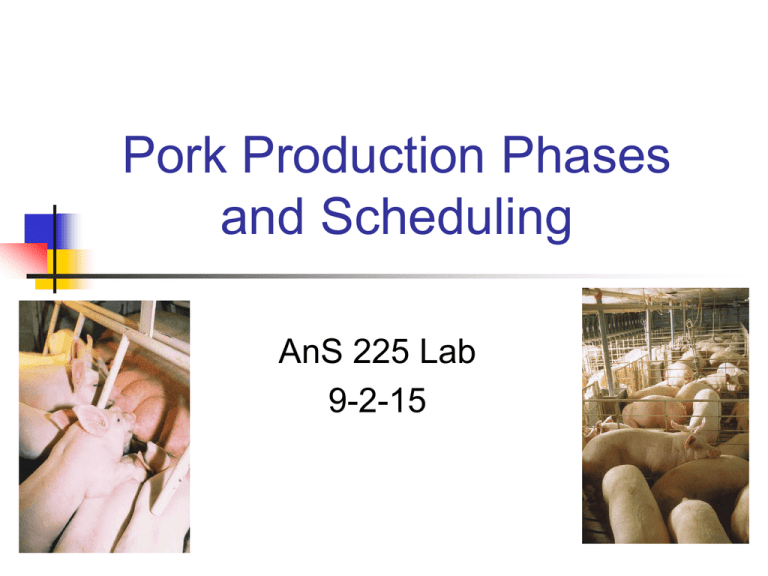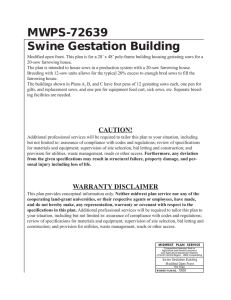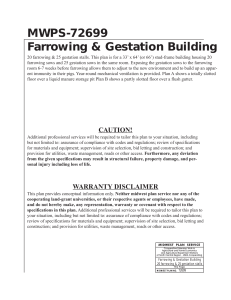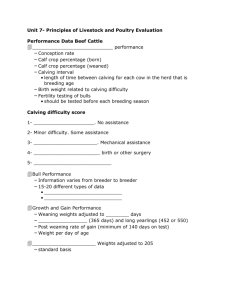Pork Production Phases and Scheduling AnS 225 Lab 9-2-15
advertisement

Pork Production Phases and Scheduling AnS 225 Lab 9-2-15 Pork Production Phases Breeding Farrowing Nursery Finishing 2 Swine Production Biological and Management Phases 3-Site Production Breeding Gestation Farrowing Nursery 2-Site Production Breeding/Gest./Farr. Wean-to-Finish Finishing Goals of Production Scheduling Even animal flow – uniform group size Same size group in all phases Minimize range in age in each group Maximize use of facilities without overcrowding Intensive use to improve economics Produce large groups of homogeneous pigs Large finishers are more economical to build Facilitate all-in/all-out for high health and to break disease cycles Utilize labor efficiently Biosecurity/Segregation Principles Best case -- no more than 7-day age variation Site Building Room All-in, all-out is key to success Many variations are possible and have proven to be successful 5 Breeding/Gestation/Farrowing “Sow Herd” Function Resources Site of mating, housing, farrowing Technology intensive Labor intensive Fundamental to economic viability Pigs born and raised is most economically important part of pork production Breeding Production Phase Types of mating systems Artificial insemination Hand mating Pen mating Facilities Environmentally controlled - individual stalls Environmentally controlled - pens Open lots in groups Hoop structures -- group housing 7 Nursery Facilities Specialized care for the weaned pig Sanitary Environmental control Critical for early weaned pigs Warm, draft-free environment needed Intense management Frequent observation Frequent feeding Finishing Facilities Wide variation in type Group size is larger 25 to 500+ pigs/pen Mechanical/natural ventilation Labor intense/labor minimal Variation in feeder type Wean-finish has become new option for many systems Pigs go direct to finishing barn at weaning – eliminate nursery phase Hoop Building for Finishing Scheduling Basics Schedules vary by farm and system Farrowing – weaning age determines time in phase Nursery – specific no. of days or weeks Finishing – time or weight? Marketing procedures will affect Top off barn? Sell as one group? Specific number of days or weeks May be feed-based – pigs marketed after predetermined amount of feed is fed Principles of Production Scheduling Gestation period – 113 to 116 days (114) Breeding period Weaning age – most weaned at approximately 21 days Weaning ages are gradually increasing Conception rates – seasonal effects First estrus occurs 4-7 days after weaning (ave. 5) Estrous cycle is 21 days Length of breeding period determines age range of pigs in group farrowed Breed more females during periods of lower conception rate to maintain group size Growth rate – affects number of days in finisher Weekly System Farrow “XX” sows per week to produce “XX” pigs per week Pigs needed per week and litter size determine number of sows to farrow Must have 4+ farrowing rooms to make work Breeding period is continuous Maximizes production and use of facilities Minimizes non-productive sows days Several variations and options are used in the industry Group System System works best for small/mid-size farms Use for farms with 1-2 farrowing rooms Allows strategic scheduling throughout the year Schedule around other farm activities – planting, harvest, etc. Usually requires longer breeding period for the group Farrow every 28 days, every 35 days, etc. May require an increase in weaning age Goal should be multiple of 7 or 21 days between group activities if possible Allows females that do not conceive to “fit” a later group Variables in Scheduling Programs Age at weaning Days in breeding period Days to first service # days in farrowing room before due date Days for clean-up between groups Gilt Pool Gilts (already cycling) waiting to be bred and added to system Needed to replace females that are culled to maintain constant group size Approximately 3X number needed per week Size of pool is farm-specific Size may need to be increased in summer months Litters/Female/Year Goal is to maximize for most farms 114-day gestation period 18-21 day lactation period 5-7 days to return to estrus Minimum of 137 days 365 / 137 = 2.66 litters/female/year (Maximum) Production Systems – Pig Flow Technology and economies of scale have driven the size of operations Minimum age spread in groups is harder to achieve in small herds Large finishers (1,000+ head) are more cost effective to build – 2450 is new standard Larger groups of sows are needed to produce large groups of pigs with minimum age spread 2450 pigs/week = 245 sows weaning 10 pigs/litter 24




